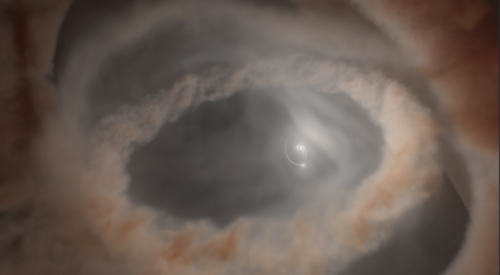Image courtesy of the European Southern Observatory.
What if you lived on a planet where the sun never set—in fact, where there were three suns? A new study by Jeremy Smallwood and his team at the University of Las Vegas, Nevada, along with collaborators from other universities, suggests that scientists may have found the first planet to orbit three stars at once. In a paper published in the Monthly Notices of the Royal Astronomical Society, researchers discovered that GW Ori—a star system 1,300 light years from Earth in the Orion constellation—is a circumtriple star system with three stars orbiting around each other within a loose, massive dust ring surrounding all three stars.
Using observations from the Atacama Large Millimeter/submillimeter Array Radio Telescope, scientists discovered a break in the disc of gas surrounding the system at 100 au (astronomical units, or the average distance from the Earth to the sun), as well as misalignments between each of the rings. Smallwood noted that there were two possibilities to explain this break in the gas disc: the triple star system’s torque, or a planet orbiting the stars that is large enough to create this gap. Through the experiment, Smallwood’s team theorized that it is likely the latter: a Jupiter-like, unhabitable planet.
In May 2020, a team from the University of Victoria in Canada first initiated an investigation into GW Ori. Using ALMA telescope observations, they identified the three dust rings at 46, 188, and 338 au and first discovered the eccentricity of the innermost ring. Another team at the University of Exeter followed up on the study later in the year, arguing that the triple star system’s torque was responsible for the gaps. Smallwood’s simulation proved otherwise, as the team saw that the torque was insufficient to tear the disc like they saw in the data.
“It was startling because we haven’t seen a planet orbiting a circumtriple disc,” Smallwood said. Planets easily form around binary star systems, but this is the first to be found orbiting around three stars. It’s more unique to only orbit one star, like in our solar system.
In protoplanetary disks of gas and dust, giant clouds of gas contract due to gravity, forming stars. As stars are born close together, their gravitational pull binds them together until they fall into relatively stable orbits. Occasionally, tighter binaries can sieve and accrete materials from others, but in this system, the stars are loose and orbiting around one another with gaps. The GW Ori system is young enough—Smallwood estimates around one to ten million years in age—that any planets would still be in their gas giant phases. But with more time, more planets might form.
The discovery of this three-star system raises the potential of planets with three stars that are habitable. “Currently, [GW Ori] is not habitable. It’s a Jupiter-like planet and it’s mostly gas. But, in ten to a hundred million years, with rocky planets forming around?” Smallwood said. Such a planet might be possible, if given the right conditions and enough time.

